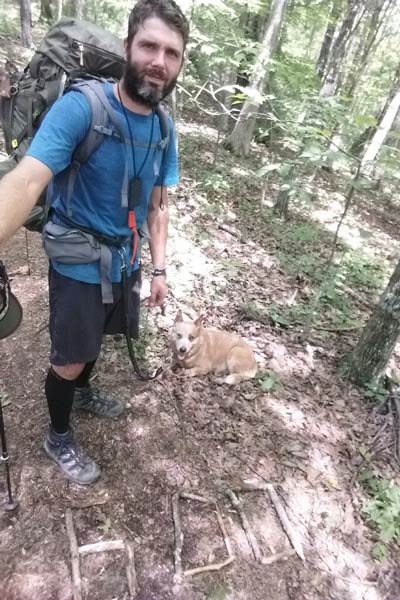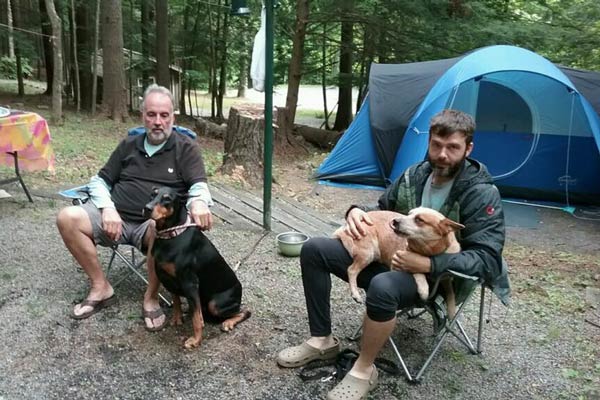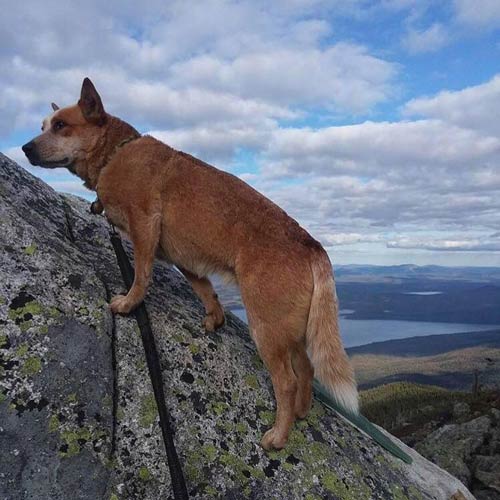
He knew beforehand that it wasn’t going to be your proverbial walk in the park.
But when 31-year-old Will Ransom, of Unadilla, Ga., and his intrepid 6-year-old Australian Cattle Dog, Rhetta, finished the Appalachian National Scenic Trail hike last month, he confessed, “It was a bit more than I bargained for.”
Their trek began in late April in Springer Mountain, Ga., in sunny 70-degree conditions and concluded 204 days later in Bennington, Vt., with snow, freezing rain, and wind blowing in their faces and temperatures in the 20s. (For those trail purists, because of inclement weather, Ransom and a hiking buddy, Gunsmoke (Louis Goldsmith, of Crested Butte, Colo., who he paired up with in Virginia) did a “flip hike,” which meant they drove to the official trail’s end in Maine, summited Mount Katahdin (5,267 feet), the centerpiece of Baxter State Park, then flipped back to Bennington, to complete the thru-hike.)
Wintry weather began forcing the closure of some shelters and trail sections, as well. “We definitely made the right call in flipping,” Ransom says. “Torrential rains made the rocky areas we were walking seem more like waterfalls than a trail. Fallen trees required us to bushwhack our way through some sections, as well.”

Wooden walkways are common along the 2,190-mile trail that strings from Springer Mountain, Ga., to Mount Katahdin in Maine.
The most challenging aspect of the entire trip, Ransom emphasizes, “was constantly looking for and reminding myself of the reason why I chose to undertake this challenge. It was mountain after mountain, shelter after shelter, tent up, tent down, the same monotonous schedule every day, step-by-step working toward the end goal. The physical and mental challenges go hand-in-hand. If you’re having a tough day mentally, it takes a toll physically, which affects your progress and productivity.”
And adding a four-legged partner boosts that intensity and focus. “I constantly had to think of her needs, too,” he adds. “She has a love of water, so any time we reached a water source, we would take extra time and let her have a good swim and play in the water. I made an effort to constantly praise Rhetta and make any natural obstacles that she had to cross more of a fun experience that she was going to receive praise for. This allowed her to stay mentally and physically stimulated.”
Adding Rhetta to the equation represented a huge responsibility – much bigger than dog ownership in the regular world. “I’m glad I took Rhetta,” Ransom says. “Having her finishing the trail was an accomplishment. Very few dogs have thru-hiked the trail. But I underestimated the challenge it would be to hike the trail with a dog. Rhetta didn’t choose to accompany me. I chose to bring her along, and as a result I had to constantly think about her welfare and make concessions to put her well-being first.

It’s break time on the Appalachian Trail for Ransom and Rhetta. The 600 in the dirt signifies the 600-mile mark on the trail from south to north.
“Even though I had to make sacrifices, she was a source of companionship and helped me through some rough stretches. We had a very special bond before the hike, and now that we have depended on each other for six months, that relationship is even tighter.”
There were times when Ransom carried the dog over sharp, rocky terrain and up steel steps constructed on huge boulders leading back to the dirt trail. And there was the sudden encounter with a bear in Shenandoah Park in Virginia. “When it saw us, it trotted away,” Ransom recalls. “But at the same time it was leaving, I heard a loud thud beside me and I looked over to see another large bear that was close enough to touch with my walking stick. He stood there staring at me like he was sizing us up. Rhetta was barking furiously and snarling at the end of the leash, trying to scare it away. It wasn’t moving willingly, so I beat the trees around it in an attempt to scare it away. I finally resorted to throwing rocks at it, until it eventually lumbered away.
“This was alarming because bears usually run away at the sight of humans on the trail. I later learned that there was a problem bear in the area that was charging hikers. And rangers agreed that this was probably the same one.”
Ransom’s biggest four-legged challenges along the route, ironically, were hikers’ unleashed, often uncontrollable dogs. “Those encounters were frustrating and dangerous,” he emphasizes. “Rhetta was leashed the entire distance for safety and courtesy, but we had several close calls with dog fights when dogs would charge directly at her around blind corners.”
Southern Maine and Northern New Hampshire were the most taxing for the pair, with steep, rugged terrain, boulders, and rocky footing. “We were warned this would be the most difficult,” Ransom explains. “There were times I would have to pick her up over ledges and areas that were too difficult for her to maneuver. Adding her weight to my pack was pretty challenging. Being a tough, resilient breed with a tenacious and determined temperament, helped her through this phase of the hike.”

Ransom and Rhetta, right, rest with a fellow hiker and his dog at a camp site, after a long day’s hike. Each day’s time on the trail was dictated by weather, trail challenges and length of daylight, particularly in the latter stages of the journey in October and November.
The pair’s daily routine went something like this: They would arise around 6 a.m., eat breakfast (for Ransom that was oatmeal and protein bars and coffee) and begin hiking shortly thereafter. Depending on the terrain, they would walk about four miles and take a break. Lunch usually consisted of cheese and cured meat, which Ransom and Rhetta enjoyed together. They would continue along, until shortly before dark, then set up camp and eat dinner (homemade dehydrated food or store-bought dehydrated meals).
Rhetta was fed a premium dehydrated dog food the length of the trip, which Ransom received in resupplied boxes from home at designated mail points near the trail. There were times when the shipments did not arrive on schedule, and he was forced to find the best dog food available in a nearby town. Rhetta underwent a complete veterinary checkup before the pair embarked on the trip, and she weighed 44 pounds; she was 38 pounds at the completion of the journey.
“We saw two veterinarians during our journey,” Ransom notes, “and both were amazed with her condition. Her pads never cracked nor were injured, which was a testament to her hardiness.” Rhetta’s lone physical issue occurred in New York state, when Ransom noticed swelling on her neck and immediately departed the trail in search of veterinary care. She was treated for an abscess in White Plains, prompting Ransom to stay overnight in a hotel, apply warm compresses, and administer antibiotics, then return to the veterinary hospital the following day for clearance to return to the trail. Rhetta healed quickly, with no complications.
Asked what advice he would offer anyone considering the Appalachian Trail hike with his/her dog, Ransom responds, “Go on a long (maybe two weeks) hike beforehand. Head out 12-to-15 miles a day. That will allow you to dial in your equipment, while judging both of your resilience and recovery from successive hard days on the trail.
“You must be prepared to be leashed to your dog virtually the entire time. You also must be ready to carry extra weight for your dog’s food, plus the inconvenience of not being able to stay in some hotels and hostels en route because you have a dog.”

There were many times when Rhetta had to scale boulders on rocky ridges with a little help from his friend. This day it was in Maine.
It’s critical your dog be well socialized, Ransom adds, since you will engage many hikers, some briefly and some for a few hours. After Ransom and Goldsmith hooked up, Rhetta accepted him as family. “Gunsmoke (Goldsmith) was a good hiking buddy because we maintained the same natural pace. He had a good sense of humor, was easygoing, and possessed a similar personality to mine. He also loved Rhetta, and Rhetta adored him. Rhetta kept a constant eye on him and where he was in relation to us when we were hiking. In other words, there was a pack mentality among the three of us.”
Successfully completing the hike was the hardest, but most rewarding experience of his life, Ransom concludes. “It was a learning experience and a journey of self-discovery. I was able to face my emotions and thoughts without distraction, which allowed me to see the direction I want my life to go. In the process, it pushed my mind and body to the brink, allowing me to discover their strength and resilience.
“Rhetta and I experienced the general goodness of people and the sense of community that the Appalachian Trail inspires and relies on for its survival. The simplicity and purity of the adventure were both addictive and highly rewarding and will remain with me for the rest of my life.”

